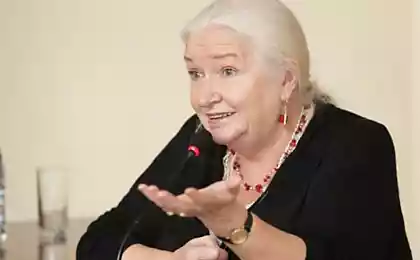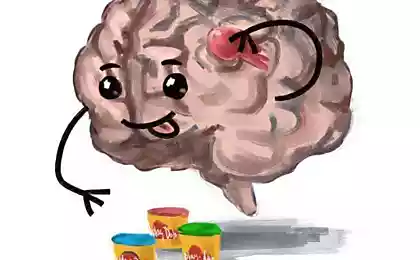235
8 thought experiments
Do you like experiments? Probably, as people curious and eager for new knowledge, most likely, yes. And did you know that experiments are not only real, conducted in special institutions or in the field, with real people and the use of specialized materials, but also mental? To be honest, we encountered them not so long ago, and almost immediately decided to share with you new information.
What is a thought experiment?A thought experiment in philosophy, physics and a number of other sciences is called a form of cognitive activity, where any situation is modeled not in the usual form of a real experiment for each of us, but in the imagination. This concept was first introduced into use by the Austrian philosopher-positivist, mechanic and physicist Ernst Mach.
Today, the term “thought experiment” is actively used by various scientists, entrepreneurs, politicians and specialists in various fields around the world. Some of them prefer to conduct their own thought experiments, while others give all sorts of examples, with the best examples of which we want to introduce you.
The most interesting thought experimentsAs the name suggests, there are eight experiments.
1. Philosophical zombieImagine a dead person alive. But not sinister, but such a modest, harmless, like an ordinary person. The only thing that distinguishes him from people is that he cannot feel anything, has no conscious experience, but is able to repeat their actions and reactions after people, for example, if he is burned with fire, he skillfully imitates pain.
If such a zombie existed, it would go against the theory of physicalism, where human perception is conditioned only by processes of the physical plane. Philosophical zombie also does not correlate with behaviorist views, according to which any manifestations, desires and consciousness of a person are reduced to behavioral factors, and such a zombie cannot be distinguished from an ordinary person. This experiment is partly concerned with the problem of artificial intelligence, because in place of zombies can be the notorious android, able to copy human habits.
2. Quantum suicideThe second experiment concerns quantum mechanics, but the position of perception changes from the position of the eyewitness to the position of the participant. Take the example of Schrödinger's cat shooting himself in the head with a gun with a mechanism that works on the decay of a radioactive atom. A gun can misfire 50% of the time. When the trigger is pulled, two quantum theories clash: the Copenhagen theory and the many-world theory.
According to the first, a cat cannot be in two states at the same time, that is, it will either be alive or dead. But according to the second, any new shot attempt divides the universe into two alternatives: in the first, the cat is alive, in the second, dead. However, the cat’s alter ego, left alive, will remain in the dark about its demise in a parallel reality.
The author of the experiment, Professor Max Tegmark, leans towards the multiverse theory. But most of the specialists in the field of quantum mechanics, who were interviewed by Tegmark, trust the “Copenhagen” quantum theory.
3.Poison and rewardThe millionaire puts before the participant of the experiment a container with poison, which does not kill a person, but causes him to suffer terribly and experience agony throughout the day. The millionaire offers the hero to drink poison tomorrow afternoon, and if he agrees, the hero will receive a million dollars even earlier – tomorrow morning. It turns out that a person is not obliged to take poison, because he will get rich before the time for taking the poison comes.
Reasoning from the point of view of common sense, you should agree to the offer, get money, but do not drink poison. But here comes into force the paradox: how does a person intend to do anything (money is paid precisely for the intention to drink poison) without intending to do it? To be honest, but not to drink poison, will not work.
4. Maria's roomThe experiment should suggest the difference between real experience and knowledge about it.
Imagine a black-and-white room in which the girl Maria sits behind a black-and-white monitor. She is a specialist in the neurophysiology of vision. She has never seen color, but she knows all about how people react to it, what they feel when they see a red rose or a blue sky, etc. Can Mary learn anything from seeing the color herself?
Here the knowledge of physicalists is refuted, who believe that knowledge is only knowledge about physical facts. But some philosophers are inclined to believe that a personal “color” experience will not hit Mary. Even if you make fun of the girl by giving her a blue banana instead of a regular banana, Maria’s theoretical background will help her react in the right way.
5. Survival lotteryBritish philosopher John Harris came up with a rather cruel puzzle. We need to imagine a world in which organ transplants are perfectly performed, and the ethics of society are such that killing a person and letting him die are one and the same. As a result, humanity agrees to participate in the “survival lottery”: if one person is at death, randomly chosen one who will sacrifice his life to save him. A donor can save several people from death, which means that the victim is statistically justified.
It would seem that everything is fair, but you do not want to live in such a world. But there is still reason to consider whether self-sacrifice is justified, and what is the line between murder and non-interference. But there is something else here: a person can push himself to the limit in many ways, but is he to blame for this, and how conscious was he during his life?
6. Curtain of IgnoranceA wonderful experiment on social justice.
For example, everything about social organization is entrusted to a certain group of people. To make the concept they came up with as objective as possible, these people were deprived of knowledge of their status in society, class affiliation, IQ, and other personal qualities that can guarantee competitive superiority.
The question is, what conception of social organization will people choose if they are unable to take into account their own personal interests?
7.China RoomA person who does not speak Chinese is in a room with baskets filled with hieroglyphics. He has at his disposal a detailed manual in his native language explaining the laws of combining unusual signs. It is not necessary to understand the meaning of all characters, since only the rules of the mark apply. But in the process of working with characters, you can create a text that is no different from the written speech of a resident of China.
Behind the door of the room are people handing the reclusive card with questions in Chinese. Our hero, taking into account the rules from the textbook, answers them – his answers do not make sense to him, but for the Chinese it is quite logical.
If we imagine the hero as a computer, the textbook as an information base, and the messages of people as questions to the computer and answers to them, the experiment will show the limitations of the computer and its inability to master human thinking in the process of simply responding to initial conditions through a programmed method.
In addition, the experiment recommends abandoning the mechanical approach to education, since even the proven skill of solving any problem is not yet an indicator that the student understands the meaning of the actions performed.
8. The infinite ape theoremBased on this experiment, the abstract monkey, if it will chaoticly beat the keys of the printing mechanism for eternity, at one point will be able to print any text originally specified, for example, “Hamlet” by Shakespeare.
Attempts were even made to implement this experiment: teachers and students at the University of Plymouth raised two thousand dollars to give six macaques a computer at the zoo. A month has passed, but the “subjects” have not achieved success – their literary heritage contains only five pages, where the letter “S” prevails. The computer was almost completely destroyed. But the experimenters themselves said they had learned a lot from their project.
You can come up with some of your own unusual thought experiments – you just need to turn on your head and move your brain. And did you not think, by the way, that many of us almost every mentally conduct all sorts of experiments involving, for example, yourself, someone close or even pets? Next time you imagine a situation, write it down on paper or even publish it – maybe your ideas will get a good development.
P.S. And remember, just by changing our consumption – together we change the world!
Join us on Facebook and VKontakte, and we are also in Odnoklasniki
Source: 4brain.ru/blog/
What is a thought experiment?A thought experiment in philosophy, physics and a number of other sciences is called a form of cognitive activity, where any situation is modeled not in the usual form of a real experiment for each of us, but in the imagination. This concept was first introduced into use by the Austrian philosopher-positivist, mechanic and physicist Ernst Mach.
Today, the term “thought experiment” is actively used by various scientists, entrepreneurs, politicians and specialists in various fields around the world. Some of them prefer to conduct their own thought experiments, while others give all sorts of examples, with the best examples of which we want to introduce you.
The most interesting thought experimentsAs the name suggests, there are eight experiments.
1. Philosophical zombieImagine a dead person alive. But not sinister, but such a modest, harmless, like an ordinary person. The only thing that distinguishes him from people is that he cannot feel anything, has no conscious experience, but is able to repeat their actions and reactions after people, for example, if he is burned with fire, he skillfully imitates pain.
If such a zombie existed, it would go against the theory of physicalism, where human perception is conditioned only by processes of the physical plane. Philosophical zombie also does not correlate with behaviorist views, according to which any manifestations, desires and consciousness of a person are reduced to behavioral factors, and such a zombie cannot be distinguished from an ordinary person. This experiment is partly concerned with the problem of artificial intelligence, because in place of zombies can be the notorious android, able to copy human habits.
2. Quantum suicideThe second experiment concerns quantum mechanics, but the position of perception changes from the position of the eyewitness to the position of the participant. Take the example of Schrödinger's cat shooting himself in the head with a gun with a mechanism that works on the decay of a radioactive atom. A gun can misfire 50% of the time. When the trigger is pulled, two quantum theories clash: the Copenhagen theory and the many-world theory.
According to the first, a cat cannot be in two states at the same time, that is, it will either be alive or dead. But according to the second, any new shot attempt divides the universe into two alternatives: in the first, the cat is alive, in the second, dead. However, the cat’s alter ego, left alive, will remain in the dark about its demise in a parallel reality.
The author of the experiment, Professor Max Tegmark, leans towards the multiverse theory. But most of the specialists in the field of quantum mechanics, who were interviewed by Tegmark, trust the “Copenhagen” quantum theory.
3.Poison and rewardThe millionaire puts before the participant of the experiment a container with poison, which does not kill a person, but causes him to suffer terribly and experience agony throughout the day. The millionaire offers the hero to drink poison tomorrow afternoon, and if he agrees, the hero will receive a million dollars even earlier – tomorrow morning. It turns out that a person is not obliged to take poison, because he will get rich before the time for taking the poison comes.
Reasoning from the point of view of common sense, you should agree to the offer, get money, but do not drink poison. But here comes into force the paradox: how does a person intend to do anything (money is paid precisely for the intention to drink poison) without intending to do it? To be honest, but not to drink poison, will not work.
4. Maria's roomThe experiment should suggest the difference between real experience and knowledge about it.
Imagine a black-and-white room in which the girl Maria sits behind a black-and-white monitor. She is a specialist in the neurophysiology of vision. She has never seen color, but she knows all about how people react to it, what they feel when they see a red rose or a blue sky, etc. Can Mary learn anything from seeing the color herself?
Here the knowledge of physicalists is refuted, who believe that knowledge is only knowledge about physical facts. But some philosophers are inclined to believe that a personal “color” experience will not hit Mary. Even if you make fun of the girl by giving her a blue banana instead of a regular banana, Maria’s theoretical background will help her react in the right way.
5. Survival lotteryBritish philosopher John Harris came up with a rather cruel puzzle. We need to imagine a world in which organ transplants are perfectly performed, and the ethics of society are such that killing a person and letting him die are one and the same. As a result, humanity agrees to participate in the “survival lottery”: if one person is at death, randomly chosen one who will sacrifice his life to save him. A donor can save several people from death, which means that the victim is statistically justified.
It would seem that everything is fair, but you do not want to live in such a world. But there is still reason to consider whether self-sacrifice is justified, and what is the line between murder and non-interference. But there is something else here: a person can push himself to the limit in many ways, but is he to blame for this, and how conscious was he during his life?
6. Curtain of IgnoranceA wonderful experiment on social justice.
For example, everything about social organization is entrusted to a certain group of people. To make the concept they came up with as objective as possible, these people were deprived of knowledge of their status in society, class affiliation, IQ, and other personal qualities that can guarantee competitive superiority.
The question is, what conception of social organization will people choose if they are unable to take into account their own personal interests?
7.China RoomA person who does not speak Chinese is in a room with baskets filled with hieroglyphics. He has at his disposal a detailed manual in his native language explaining the laws of combining unusual signs. It is not necessary to understand the meaning of all characters, since only the rules of the mark apply. But in the process of working with characters, you can create a text that is no different from the written speech of a resident of China.
Behind the door of the room are people handing the reclusive card with questions in Chinese. Our hero, taking into account the rules from the textbook, answers them – his answers do not make sense to him, but for the Chinese it is quite logical.
If we imagine the hero as a computer, the textbook as an information base, and the messages of people as questions to the computer and answers to them, the experiment will show the limitations of the computer and its inability to master human thinking in the process of simply responding to initial conditions through a programmed method.
In addition, the experiment recommends abandoning the mechanical approach to education, since even the proven skill of solving any problem is not yet an indicator that the student understands the meaning of the actions performed.
8. The infinite ape theoremBased on this experiment, the abstract monkey, if it will chaoticly beat the keys of the printing mechanism for eternity, at one point will be able to print any text originally specified, for example, “Hamlet” by Shakespeare.
Attempts were even made to implement this experiment: teachers and students at the University of Plymouth raised two thousand dollars to give six macaques a computer at the zoo. A month has passed, but the “subjects” have not achieved success – their literary heritage contains only five pages, where the letter “S” prevails. The computer was almost completely destroyed. But the experimenters themselves said they had learned a lot from their project.
You can come up with some of your own unusual thought experiments – you just need to turn on your head and move your brain. And did you not think, by the way, that many of us almost every mentally conduct all sorts of experiments involving, for example, yourself, someone close or even pets? Next time you imagine a situation, write it down on paper or even publish it – maybe your ideas will get a good development.
P.S. And remember, just by changing our consumption – together we change the world!
Join us on Facebook and VKontakte, and we are also in Odnoklasniki
Source: 4brain.ru/blog/
Philanthropy in its purest form: a woman from China all their multi-million dollar fortune spent on orphans
Fast diet recipe: poppy seed casserole























